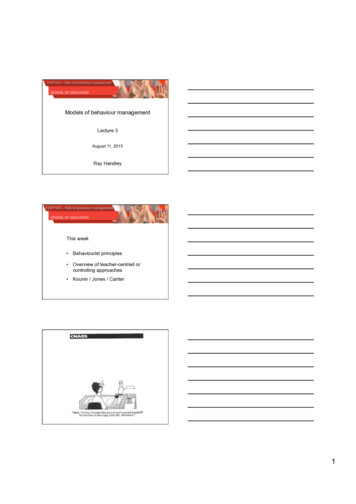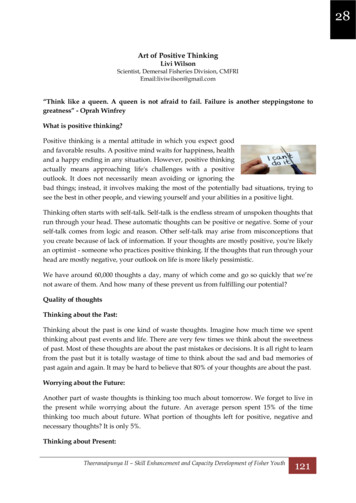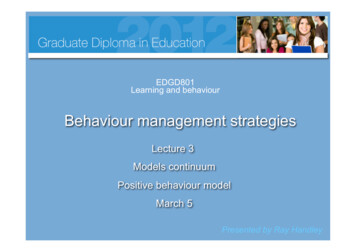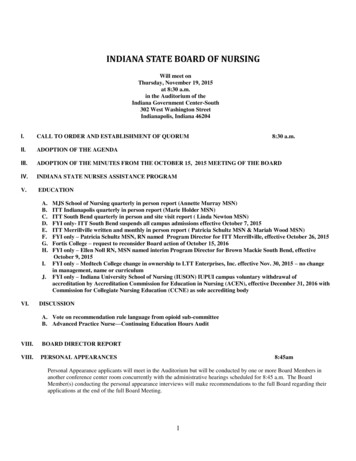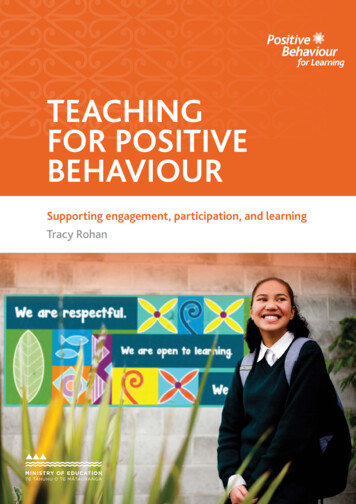
Transcription
TEACHINGFOR POSITIVEBEHAVIOURSupporting engagement, participation, and learningTracy Rohan
AcknowledgmentsThe Ministry of Education wishes to thank: the writer, Dr Tracy Rohan the teachers and students who appearin photographs throughout this resource the New Zealand schools that have beenpart of PB4L–SW and that have informedthis resource.Published by the New Zealand Ministry of Education.www.education.govt.nzAll text and images copyright Crown 2017, except for thetraditional whakataukī on page 1, and the table on page 53,which is copyright the University of Missouri Center forSchoolwide Positive Behavior Support.All rights reserved. Enquiries should be made to the publisher.Dewey number 371.5ISBN 978-1-77669-185-2Item number 77669
Te piko o te māhuri,tērā te tupu o te rākau.The way a sapling isnurtured determines howstrong it will grow as a tree.TEACHING FOR POSITIVE BEHAVIOUR1
2TEACHING FOR POSITIVE BEHAVIOUR
ContentsAbout this resource5Introduction6Culturally responsive practices8Caring relationships8Inclusive pedagogies9Inquiry and problem solving10The foundation: The New Zealand Curriculum11Section 1: Creating a supportive learning environment13Collaboratively developing behaviour expectations14Establishing a supportive physical environment16Establishing and explicitly teaching routines17Using preventative strategies20Providing feedback and encouragement22Providing feedback and fair consequences for problem behaviour24Section 2: Encouraging reflective thought and action27Encouraging self-regulated behaviours28Supporting students to manage their learning30Supporting goal setting and self-reflection on learning and behaviour33Section 3: Facilitating shared learning35Teaching social behaviours for group work36Using cooperative learning approaches38Helping students to mentor and support the learning and behaviour of others41Section 4: Providing sufficient opportunities to learn43Presenting information and tasks in a variety of ways to support understanding44Providing alternatives for students to demonstrate their learning46Supporting student responses48Providing choice49Structuring tasks strategically50Section 5: Reflection, inquiry, and problem solving54Whole-school inquiry55Collaborative problem solving56Teacher self-assessment62References67TEACHING FOR POSITIVE BEHAVIOUR3
4TEACHING FOR POSITIVE BEHAVIOUR
About this resourceThe purpose of this resource is to support teachers in New Zealand primary and secondary schoolsto understand and draw on effective practices that enhance students’ behaviour, engagement,participation, and learning. Professional development facilitators and school leaders will also findit useful in their work with teachers and communities of learning in the areas of effective pedagogyand behaviour support.The resource has been written for teachers in all New Zealand schools. For schools involved inPositive Behaviour for Learning School-Wide (PB4L–SW), the resource also serves as a companiondocument to the Tier One and Two implementation manuals.1The resource is organised around four major sections based on key pedagogical approaches fromThe New Zealand Curriculum (Ministry of Education, 2007). Each section discusses a range ofstrategies whose effectiveness has been proven by extensive research in New Zealand and overseas.These strategies: align with established New Zealand pedagogy (e.g., as outlined in The New Zealand Curriculum) promote self-regulated learning behaviours (in particular the key competencies of relating toothers, participating and contributing, and managing self) support student-to-student interactions and relationships as well as teacher-facilitated learning promote culturally responsive practices that are inclusive and deeply embedded are applicable to both traditional and more flexible, innovative learning environments can be supported using appropriate digital technologies support schools to take a reflective, problem-solving approach.The resource also includes activities designed to support staff professional learning and development,and links to further information, including video clips, websites, and online fact sheets. If you areworking with hard copy, you will need to access the online version on TKI at terial in order to activate many of these links.Section 5 (Reflection, inquiry, and problem solving) and the activities in sections 1–4 will beparticularly useful when staff are working together to build their knowledge and expertise –for example, during PLD sessions or PB4L–SW workshops. In this way, your use of the resourcewill align with the approach you take to whole-school inquiry and collaborative problemsolving – adopting a reflective, inquiring frame of mind to ensure all your students areparticipating and learning in an inclusive community.See terial for the PB4L–SW Tier One and Two implementation manuals.Schools that are not part of PB4L–SW may order a hard copy of the Tier One manual from the PB4L–SW practitioner in theirlocal Ministry of Education office.1TEACHING FOR POSITIVE BEHAVIOUR5
IntroductionStudents learn best when they feel accepted, when they enjoy positiverelationships with their fellow students and teachers, and when they areable to be active, visible members of the learning community. Effectiveteachers foster positive relationships within environments that arecaring, inclusive, non-discriminatory, and cohesive.The New Zealand Curriculum, page 34Teachers in New Zealand understand the importance of creating environments for learning that areunderpinned by positive relationships and inclusive values. One of the key challenges for all teachersis implementing strategies that will support all students to be successful when their needs are oftencomplex and influenced by many factors.Many students who experience behavioural challenges also experience some difficulties withlearning. Therefore, inclusive pedagogical strategies that support both learning and behaviour areneeded. This resource focuses on effective, inclusive strategies that support learning and behaviourand that will support the development of key competencies needed for academic and social success.These strategies align with international and New Zealand research by, for example: those working in the area of effective teaching, such as Adrienne Alton-Lee (2003) and JohnHattie (2012) those working in the area of positive behaviour support, such as George Sugai and Rob Horner(2005), Tim Lewis (1999), and Geoff Colvin (2010) those researching culturally responsive pedagogies and practice, such as Angus Macfarlane(2004), Sonja Macfarlane (2015), and Russell Bishop (2003) those focusing on inclusive schooling, such as Suzanne Carrington and Jude MacArthur (2012).The strategies also align with the principles of Universal Design for Learning, which promote a rangeof options enabling students to participate in learning in ways that work best for them and that areresponsive to diversity.The strategies will work best in learning spaces in which student diversity is used effectively asa pedagogical resource and teachers work in partnership with whānau. In such spaces: teachers have high expectations of all learners the climate is inclusive, positive, and celebrates difference students are active participants in curriculum decision making teaching and learning relationships are built on mutual trust, respect, and an ethic of care6TEACHING FOR POSITIVE BEHAVIOUR
inclusive language acknowledges diverse perspectives and different ways of behaving,feeling, and knowing learning contexts and resources are culturally inclusive and reflect the diversity ofstudent experience instructional practices nurture and celebrate students’ identities, languages, and cultures.Figure 1 shows the framework for this resource. Underpinning teaching for positive behaviour is The New Zealand Curriculum. The strategies promoted by the resource are discussed under four teaching approachesthat the curriculum identifies as consistently having “a positive impact on student learning”and for which there is “extensive, well-documented evidence” (page 34). These approachesconstitute the four major sections of the resource and are shown around the centre of thecircle in Figure 1. Figure 1 also shows, around the outside, four elements that underpin these teachingapproaches and that will support you to increase engagement and maximise learning forall students in your care. These elements are discussed after Figure 1.urallyrespoZealandweNCreating asupportive learningenvironmentCari ngrelshipnsioCulticestcapresivatnFigure 1: Teaching for positive behaviour – Key approaches and elementsEncouragingreflective thoughtand actionpedagiesC u rr i l u mcuprobveusigoProviding sufficientopportunitiesto learnandInclFacilitating sharedlearninglemsolvingTeachingfor PositiveBehaviourI nqyuirTEACHING FOR POSITIVE BEHAVIOUR7
CULTURALLY RESPONSIVE PRACTICESCulturally responsive practices are a key part of supporting students to be successful in school.Responsive pedagogies and practices require ‘cultural consciousness’ on the part of school leadersand teachers. The culturally conscious teacher rejects deficit theories about any individual or groupof students and understands that students’ behaviour and learning are influenced by language andculture. Such a teacher will draw on students’ identities to enhance engagement and achievement(Macfarlane et al., 2015).Many schools are on a journey towards culturally responsive practice and pedagogy. They canstrengthen their practices in this area by engaging with professional learning and development,supported by collaborative inquiry in their school and across their communities of learning. TheNZCER Wellbeing@School and Inclusive Practice tools provide useful ways for schools to measureprogress in the areas of inclusion and cultural response.CARING RELATIONSHIPSPositive relationships are central to the development of a supportive learning environment.The practices set out in this resource will support positive relationships between you and yourstudents and among your students.Much research in education has explored and highlighted the importance of the relationshipbetween the teacher and the student as an integral part of effective teaching (e.g., Alton-Lee, 2003;Bishop, 2003; Hattie, 2009; Margrain & Macfarlane, 2011; Macfarlane et al., 2015 & 2017). It is wellestablished in this area of research that both academic achievement and student behaviourare influenced by the quality of the teacher–student relationship.In New Zealand, caring relationships and classroom management are seen as key aspectsof culturally responsive practice. For example, ‘The Te Kotahitanga effective teaching profile’(Bishop and Berryman, 2009) includes: caring for students as culturally-located human beings above all else caring for the performance of students being able to create a secure, well-managed learning environment being able to engage in effective teaching interactions with Māori as Māori using strategies that promote effective teaching interactions and relationships with learners promoting, monitoring, and reflecting on outcomes that in turn lead to improvementsin educational achievement for Māori students.8TEACHING FOR POSITIVE BEHAVIOUR
INCLUSIVE PEDAGOGIESInclusive pedagogies benefit all students. They are designed to ensure that all students are engaged,challenged, and experiencing success in an environment that supports and promotes their academicand social learning.Inclusive schools enact inclusive values, developed in partnership with whānau and providingthe ‘pūmanawatanga’ or beating heart that determines how a school looks, feels, and soundsfrom the perspective of students, teachers, and whānau (Macfarlane et al., 2007; Carrington &MacArthur, 2012).Inclusive teachers ensure that they identify and remove barriers to participation and learning sothat every child has the opportunity to reach their potential. This resource promotes strategies thatare supported by evidence of effectiveness for all learners and that are particularly appropriate forremoving barriers to participation and learning for students with behavioural challenges.FLEXIBLE TEACHING AND LEARNING SPACESIncreasingly New Zealand schools include flexible teaching and learning spaces that supportinclusive pedagogies. In these spaces, students can work independently, in small groups, oras a large group depending on the context for learning and task requirements. Students maybe learning in a main teaching space, a project or presentation space, a break-out space, oroutside the classroom. Learning may be teacher-facilitated, student-initiated, co-constructed,or driven by a personalised inquiry. The programme may be significantly differentiated inresponse to the particular strengths and needs of diverse learners. Students may be workingon cooperative tasks and in composite groups of older and younger students. Their learningmay be facilitated by two or more teachers who work collaboratively.It is important that the environment itself provides as much support as possible, throughhelpful signage, audio support systems such as intercoms, low-noise and low-light areas,break-out spaces for small-group work, and visual reminders that support time and taskmanagement.The opportunities these spaces give to students to work independently or collaboratively andwith different adults working in the space highlight the need for explicit teaching of behaviours– for example, those needed to work cooperatively, share resources and ideas, take turns, seekhelp, manage momentary confusion or frustration, and self-manage in a stimulating or busyenvironment.As part of this teaching, it is vital to give feedback to students as they become fluent with thebehaviours and competencies needed to work in different ways. Teachers need to strengthentheir deliberate ‘noticing’ when students show self-regulated behaviours, independence andinitiative, good decision making, and a sense of social responsibility by helping others andworking well in small or large groups.TEACHING FOR POSITIVE BEHAVIOUR9
INQUIRY AND PROBLEM SOLVINGWell-being and positive behaviour support are often a focus of communities of learning as theydevelop ways to meet their particular challenges. Section 5 of this resource provides examples ofways in which you can inquire into your behaviour support practices and trial and evaluate newapproaches to benefit your students. In this way, the inquiry process will provide opportunities foryou to explore evidence, trial particular strategies, identify areas for further professional learning,and share effective practice with others.ALIGNMENT WITH PB4L–SWRegardless of whether you are working in a more traditional single-cell classroom or a flexiblespace, you will be able to apply problem-solving approaches and strategies that you arefamiliar with from PB4L–SW Tier One. For example: The strategies that you choose to support positive behaviour will align with the values andexpectations that you have developed as part of Tier One’s implementation. Other familiar Tier One strategies such as ‘active supervision’ can be usefully adapted toinside learning spaces. Teachers who move, scan, and interact in energetic, intentional waysare more likely to have students who are focused and engaged. They are able to notice andaddress student issues in ways that are responsive and preventative. Most importantly, in alearning space that operates as a learning community and that has in place tuakana–teina,peer mentoring, and strong cooperative working relationships, supervision will not simplybe about the teacher–student relationship. Students who have positive relationships witheach other will supervise each other, providing prompts, feedback, and help to one another. Tier One stresses the importance of developing routines. This resource provides furtherguidance about developing routines for learning spaces that align with school-wideexpectations. These routines need to be clear to everyone to ensure the smooth running ofteaching and learning spaces. They provide students with the security of knowing what todo to manage resources, to complete activities, to seek help, and to use technologies anddevices safely and responsibly.Problem solving is also a key part of PB4L–SW Tier Two. Groups of teachers support each otherto trial strategies aimed at reducing problem behaviour for students who have not respondedto universal (Tier One) approaches. If this is not successful, the Tier Two Team analysesstudents’ behaviour to identify an appropriate intervention to further support the students.10TEACHING FOR POSITIVE BEHAVIOUR
THE FOUNDATION: THE NEW ZEALAND CURRICULUMThis resource clearly aligns with the New Zealand Curriculum and supports schools’ work within it.As discussed above, its four major sections are based on pedagogical approaches from theNew Zealand Curriculum that are particularly relevant to supporting positive behaviour: Creating a supportive learning environment Encouraging reflective thought and action Facilitating shared learning Providing sufficient opportunities to learn.Figure 2 overleaf expands on Figure 1 to show the strategies discussed within each of theseapproaches. Through reflective inquiry you will be able to trial and adapt the suggested strategiesand deepen your expertise and understanding of them. The strategies have a strong evidence base;when underpinned by warm, caring relationships and a culturally responsive, inclusive pedagogicalapproach, they will result in increased engagement and improved participation and learning.TEACHING FOR POSITIVE BEHAVIOUR11
Figure 2: Evidence-based strategies for teaching for positive behaviourStrategiesStrategies Collaboratively developing behaviour expectations Encouraging self-regulated behaviours Establishing a supportive physical environment Supporting students to manage their learning Establishing and explicitly teaching routines Supporting goal setting and self-reflectionon learning and behaviour Using preventative strategies Providing feedback and encouragementZealandNewCari ngrensurallyresposticecapris vetiolan Providing feedback and fair consequences forproblem behaviourCultsEncouragingreflective thoughtand actionhipCreating asupportive learningenvironmentpeprobveusidagoProviding sufficientopportunitiesto learngiesCurriculumndInclFacilitatingshared learninglemsolvingTeachingfor PositiveBehaviourInir yquaStrategiesStrategies Teaching social behaviours for group work Using cooperative learning approaches Presenting information and tasks in a varietyof ways to support understanding Helping students to mentor and supportthe learning and behaviour of others Providing alternatives for students to demonstratetheir learning Supporting student responses Providing choice Structuring tasks strategically12TEACHING FOR POSITIVE BEHAVIOUR
Section 1: Creating a supportivelearning environmentCreating a supportive learning environment that helps students to develop the competencies ofself-management, participating and contributing, and relating to others is a priority for all teachers.This section aims to help you, in collaboration with your students, to create an environment whereyour students feel valued, included, supported, and secure, and in which they take responsibilityfor themselves and others. There will be routines in place that promote safety, smooth transitionsbetween activities, and a calm and cooperative space for learning and socialising. The environmentwill be inclusive, underpinned by the shared values of home and school, and supportive of the needsand aspirations of Māori and Pasifika learners and their whānau.Six important strategies support the development of a positive, proactive, and instructional approachto behaviour in any school: Collaboratively developing behaviour expectations Establishing a supportive physical environment Establishing and explicitly teaching routines Using preventative strategies Providing feedback and encouragement Providing feedback and fair consequences for problem behaviour.To check how effectively you are making use of these strategies, you could ask: Have we developed clear and positively stated expectations for behaviour? Do we ensure the school environment supports all students in their learning? Have we taught our behaviour expectations to all our students? Do we provide positive feedback when students meet these expectations? Do we anticipate problem behaviour and act to prevent it from occurring? Do we intervene quickly when inappropriate behaviour occurs and use it as a teachingopportunity?If your school is a PB4L–SW school, you will already be making use of these strategies as you putthe essential features of Tier One in place. The rest of this section looks at each of the strategiesin detail.TEACHING FOR POSITIVE BEHAVIOUR13
COLLABORATIVELY DEVELOPINGBEHAVIOUR EXPECTATIONSEvery school needs to identify and put in place expectations for behaviour for both teaching andnon-teaching spaces. Using an agreed set of expectations across the school ensures a consistentapproach. This clarity and consistency helps students to reflect on and monitor their own behaviour.The work of Bishop and Berryman (2009, 2010) emphasises the importance of teachers having highexpectations for the learning and behaviour of all students (mana motuhake). Effective teachersclarify the social and learning behaviours needed to be successful for each setting or activity.For example, the Huakina Mai process in ‘The Hikairo Rationale’ involves the teacher establishingexpectations at the very start of interactions with students (Macfarlane, 1997 & 2000). The teacherthen reviews and reteaches these expected behaviours regularly, ‘catching’ students being successfuland providing helpful, corrective feedback when needed.If your school is a PB4L–SW school, the process for developing behaviour expectations will havebeen a key part of Tier One implementation. The expectations will align with the core values ofyour school and your wider school community. They will have been carefully and collaborativelydeveloped so that they are relevant to the different settings for learning and socialising at school,and they are likely to be displayed on a matrix – an accessible way of organising and displaying theexpectations so that they can be easily referred to for teaching and feedback purposes.If your school is not a PB4L–SW school, the process for collaboratively developing expectations forbehaviour could include the following: Discuss with your students the behaviours that will help to ensure a calm working environment inwhich they can make decisions that enhance their learning and relationships. These expectationscould link to 3–5 core whole-school values such as Be respectful, Be responsible, and Be a learner,or Care for self, others, and the environment, or We demonstrate manaakitanga, rangatiratanga, andkaitiakitanga. Agree on a group of expectations that will support positive learning and social behaviour, andword them in ways that everyone can understand and remember. It is helpful for students if, forexample, all junior school, or year 9 and 10 classes, share the same behaviour expectations andif the expectations further up the school are based on these but with adaptations relevant to theage group. Consistency and predictability help all students to know what is expected of them. Display the expectations where they can easily be used as a tool to support studentself-management.14TEACHING FOR POSITIVE BEHAVIOUR
At an East Coast high school there is a strong focus on service leadership as well as arestorative approach to the preservation and strengthening of relationships. Demonstratingrangatiratanga (‘chiefly’ qualities) through school and community service is at the heart ofthe school’s values. In the classroom this translates into a set of behaviour expectations thathave been developed by the students for the students. These behaviour expectations provideguidance about the responsible use of information technology and social media, respectfulways of communicating, work effort and task perseverance, and working in ways that willlead to collective as well as individual success. For example, students have agreed to providepositive role modelling for younger students, acting as tuakana, and to ensure that when theywork in groups, all members of the group receive ‘awhi’ and ‘tautoko’ from their peers to helpthem achieve shared goals. The school is a restorative school, and so students are reminded totake responsibility when they make behavioural mistakes in the classroom and to take steps torestore relationships that have been damaged.Section 4 (available under ‘Download the manual’ at erial) of the PB4L–SW Tier One manual provides guidance andresources for collaboratively developing behaviour expectations with students and thewider school community.TEACHING FOR POSITIVE BEHAVIOUR15
ESTABLISHING A SUPPORTIVE PHYSICAL ENVIRONMENTThe physical environment your students experience plays a vital role in supporting positivebehaviour. It can help to promote learning and prosocial behaviour2 by providing spaces forindependent work and purposeful talk and interactions, access to information technology, andvisual prompts for using strategies when needed. It can also facilitate the celebration of diversityby displaying images of diverse peoples engaged in a range of activities, iconography that reflectsthe cultural narrative of the area, and the language(s) of tangata whenua and other groups in yourcommunity. This all helps to signal to your students that their cultural identities are valued.Increasingly, learning spaces in New Zealand are allowing levels of flexibility and choice that areexciting for self-managing, self-regulated students. For students with behavioural challenges orthe need for additional support, it is especially important to ensure that their learning spaces areunderpinned by the principles of Universal Design. These principles reflect the assumption thatphysical and instructional environments should support and enable all students to be successful.There are a number of key considerations for providing a supportive physical environment: Create a space that allows ease of access and movement and minimises crowding and distraction. Ensure that temperature, lighting, acoustics, and furniture support learning for all students. Provide independent work spaces to support self-management and allow students to choose towork away from distraction in a quiet space. Ensure that visual images and resources reflect the cultural diversity of New Zealand, and inparticular, our dual cultural heritage. Display visual supports around the room with key messages about routines and strategies thatsupport self-management and collective responsibility for learning and behaviour. Explicitly teach the routines and behaviours needed to use the physical space to its potential– for example, how to retrieve, use, and return digital devices and other materials, how to usebreak-out spaces, and how to share space with large groups of students during hui time or othercombined group activities.For detailed information in relation to this strategy, see the Ministry of Education’sfactsheets3 Flexible Learning Space: How the design of spaces can help studentachievement, Flexible Learning Spaces: Making spaces work for everyone, Furniture,fittings and equipment in a modern learning environment, and Māui whakakau, kurawhakakau: Teaching and learning environments to support priority learners.A video on YouTube featuring West Rolleston School provides an example of a modernlearning environment in action.The OECD’s 2017 Handbook on Innovative Learning Environments discusses principles anda framework for designing innovative learning environments.Prosocial behaviour can be defined as positive actions that benefit others, prompted by empathy, moral values, and a senseof personal responsibility rather than a desire for personal gain (Kidron & Fleischman, 2006).3Remember that if you are working with hard copy, you will need to access the online version of this resource on TKI material in order to activate many of the links for additional information.216TEACHING FOR POSITIVE BEHAVIOUR
ESTABLISHING AND EXPLICITLY TEACHING ROUTINESSensible routines help to set your students up for success. Ideally, they will be developedcollaboratively, ensuring that your students have participated in the discussions and negotiationsthat decide how everyone will work, socialise, and play in the places where learning happens inyour school.If your school is a PB4L–SW school, the routines for your teaching and learning spaces will reflectthe school’s broad expectations and matrix of expected behaviours. Having routines in place foractions such as getting and returning materials, transitioning between activities or spaces, earlyfinishing, using activity centres, asking for help, and working with a partner or in groups improvesthe flow of activity and instruction and helps create a calm, well-ordered environment for learning.When you and your students have decided that a routine is needed for a particular situation orway of working, discuss with your students: Why do we need this routine? When do we need it? How will it help us to learn, play, or socialise together? What do we expect to happen in the routine? What would work to remind us to follow the routine? (e.g., signage, a signal, tuakana providingprompts and reminders to teina)Then describe the routine in a way that is accessible and manageable for all students. Word theroutine in
Underpinning teaching for positive behaviour is The New Zealand Curriculum. The strategies promoted by the resource are discussed under four teaching approaches that the curriculum identifies as consistently having “a positive impact on student learning” and for which
